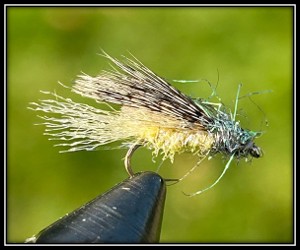May Fly of the Month
Grouse Caddis Emerger
Dean Wellman, BRSC Financial Secretary – Brule, WI
I had an experience last May that prompted me to point out the importance of emergers during a hatch. One nice afternoon, I grabbed my 5-wt and the flies that I tied over winter and I drove to the cabin to see if anything was hatching. I could see fish rising and caddis flies coming off the water as I approached the river. I sat on the bench and watched for several minutes. There were 3 or 4 smaller fish rising upstream and 2 or 3 larger fish rising downstream in a seam created by some alders. The rises were splashy and aggressive. A hatching caddis would quickly emerge out of the water. It would take about a 1-foot hop, then a 2-foot hop, and then a 4-foot hop. After the last hop, it would fly to the trees. No fish were taking the hopping caddis flies after they emerged.
I decided to put on a size 16 CDC caddis, which looked like the right size, and I cast to the smaller fish because I wanted to make sure I had the right fly on before trying the bigger fish. All had refused the fly after a few nice casts. After further observation, I could see the caddis coming out of their shucks. The shuck would appear as a small tube, sometimes at a different angle as it separated from the adult caddis. Fish were eating the caddis and the shuck. Emergence was really fast with the flies most vulnerable during emergence; hence, the quick, splashy rises. Once the caddis started the hopping routine, they were not as vulnerable and the fish didn’t make an effort to grab them.
My next move was to try an olive grouse emerger with a trailing shuck that I copied from Mike Lawson’s Partridge Caddis Emerger https://www.youtube.com/watch?v=nBZuiBIyBpo. I substituted our ruffed grouse for the Hungarian partridge and Prism SLF peacock dubbing for the peacock herl Mike uses. I caught 3 of the smaller fish immediately. After celebrating my discovery, and with bigger fish still rising below me, I cast to the biggest fish. A very large drop-back steelhead rolled on the fly on my first cast. I waited for the line to tighten, but nothing! Now what? I decided to change flies, and put on an emerger with a lighter-colored body. On my next cast, the line tightened, I had a bus attached to my 4 lb tippet, and I’m in tennis shoes on the bank! Needless to say, this bus continued downstream towards the lake and broke me off in seconds.
Recipe
- Hook: Tiemco TMC 100 in size 14 or 16.
- Thread: Olive 8/0 UNI-thread. Attach the thread mid-shank and overwrap to the bend and back.
- Rib: Fine gold wire. Attach and overwrap to the hook bend. This will be used in step 6.
- Body: Light olive dun Wapsi Antron Sparkle Dubbing. Dub a body that is a little thicker and stubbier than a mayfly body and a little more than half the length of the hook shank.
- Trailing Shuck: Cream Antron yarn. Position a 2-inch clump of 8 – 12 fibers on top of the hook shank just ahead of the body. Tie it in at the middle of the clump with 1/2 to the rear. This rear piece will be overwrapped in the next step.
- Rib: While holding 1/2 of the Antron yarn to the rear, overwrap the yarn with the wire making segmented wraps. Tie off the wire and trim the excess. Trim the trailing shuck to hook shank length with a slight taper.
- Underwing: Fold back the other 1/2 of the Antron yarn and tie it down. Trim it just past the hook bend.
- Wing: Take 2 feathers from the rump of a ruffed grouse and place them on top of each other. Fold back the fluff (the stems on these feathers are fragile so do not try to remove the fluff) and pinch the two feathers together at the tie-in point. Then, tie them down on top of hook shank. This wing should extend a little past the Antron underwing. The wing can be on the short side as the adult is just emerging. Trim the excess once you’re satisfied with the wing position.
- Head: You should have about 1/8th inch of space left to dub a small head of peacock SLF Prism Dubbing. You can pick this out a little for a leggy look. Whip finish.
To see our past patterns, click on Past patterns.
